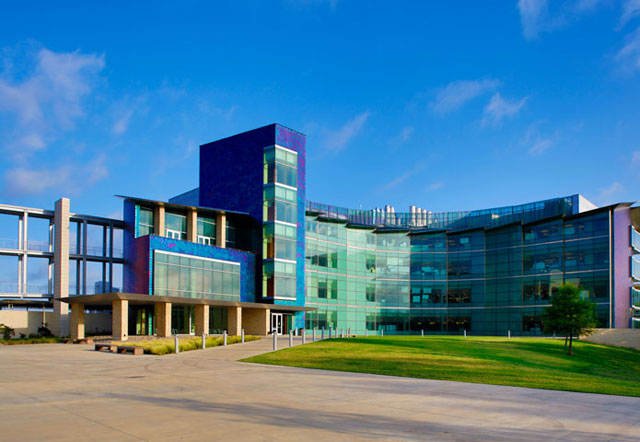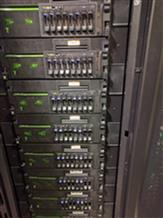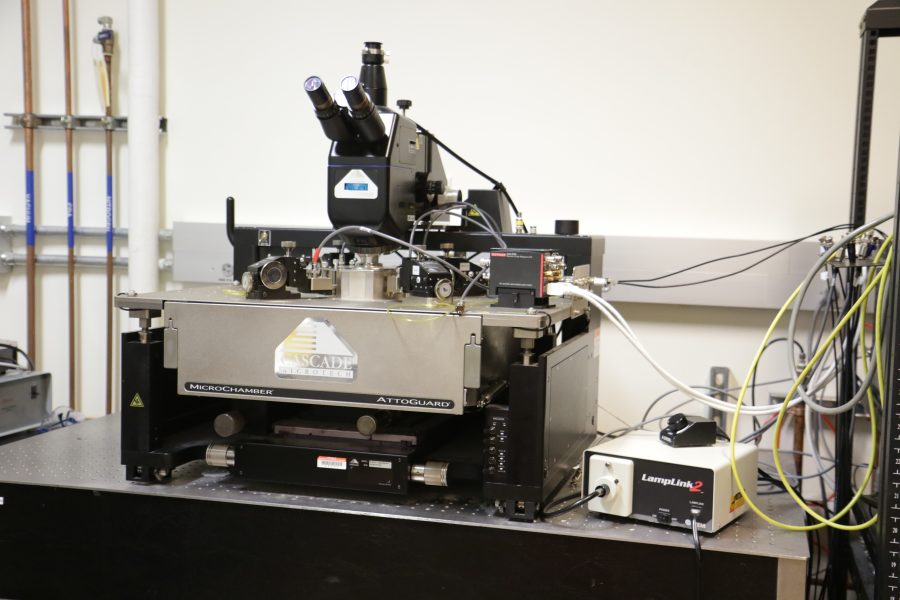EQUIPMENT AND FACILITIES
Providing students with the necessary equipment to expand on ideas and research is vital in promoting modern innovation. The equipment and facilities described below are housed in the $85 million Natural Science and Engineering Laboratory (NSERL) building. These capabilities will provide graduate students with tools uniquely suited to engage in research areas of modern materials science and engineering. Students are encouraged to learn more about MSE facilities and equipment such as their capabilities and availability.

MSE FACILITIES
ALD Capability – Thin Film Deposition and Characterization
This laboratory has the ability to control and characterize all interfacial regions associated with the high-k dielectric/III-V gate stack. A unique multi-module cluster system is utilized for the fabrication and characterization of dielectric (and contact electrode) films on the III-V substrates.
Learn more on Dr. Jiyoung Kim’s research group page
Computational Materials Science Facilities

Materials modeling software tools and hardware facilities are available for nanoscale materials research. Atomistic modeling software tools are used for structure and dynamic analysis of diverse material systems at nanoscales, and the examples include nanoelectronic materials and nanomaterials for renewable energy applications. Computer programs based on density functional theory (DFT) software tools (VASP, ABINIT, PWSCF, and SIESTA) and empirical-pseudopotential (developed in-house) are used for quantum mechanical analysis of materials. In-house semiclassical (based on the Monte Carlo method) and quantum transport modeling software tool (based on the non-equilibrium Green’s function (NEGF) and the Master equation methods) are used for I-V calculation of nanoelectronic devices .
These software tools are available on several computer platforms: 1. A dedicated high-performance cluster consisting of 12 IBM-755 nodes containing 32 IBM Power-7 cores and 256 GB RAM each making for a total of 384 cores and 3 TB RAM; 2. A computational research computing cluster, called Ganymede, that is being developed at UT Dallas. The cluster was started with: 20 Dell R730 computers with dual 20 core CPUS, 256GB RAM four nVidia K1 GPU’s, a high performance parallel storage system running gpfs from DDN, a 100 Gbps capable infiniband interconnect and two 32 port Cisco Nexus 9000 series 10 Gbps Ethernet switches. 3. 11 Linux and AIX workstations which are used to run small workloads and to connect to the several high-performance resources at our disposal. These software and hardware tools are also used for class projects in MSEN 5377.
Molecular Beam Epitaxy
A unique multi-chamber MBE has been established with each of the VG-Semicon growth chambers linked together with a UHV transfer tube system operating at a base pressure of about 10-11 mbar. II-VI growth is performed in a V80H growth chamber equipped with two vertical e-beam evaporators, enabling the growth of high melting temperature metals such as Hf, Mo, W, and Fe, in addition to effusion cell evaporation of Se, Te, Zn, Bi, and Be. The two e-beam evaporators allow for TMD and topological insulator heterostructure growth as well as mixed transition metal TMDs and magnetic doping, providing significant flexibility in material and device design. The chamber is also equipped with ZnCl2 and nitrogen plasma sources for doping and surface functionalization. The III-V chamber is also a V80H with recently upgraded hardware and software to provide state-of-the-art growth capabilities including In, Ga, As, B, Al, and N compounds as well as in-situ H-cleaning and Be and Si doping. The Group IV chamber, a V90S, is used to grow Si, Ge, and Sn epitaxial films,SiSnGe compounds, and strained heterostructures. The vertical growth chamber in this system incorporates electron-beam evaporators and effusion cells for Sb and B doping. Preparation chambers with high temperature heating stages are available for each material system. Each growth chamber is equipped with in-situ RHEED allowing us to assess the growth quality in real-time.
Learn more on Dr. Chris Hinkle’s research group page
Multiscale Simulation Lab
This lab focuses on three research themes including Lithium-ion battery, Catalyst and 2D Materials using Density Functional Theory (DFT) Simulation.
Learn more on Dr. Kyeongjae Cho’s research group page
Surface Science System
The system enables detailed studies of surface reactions and structure at the atomic scale.
Learn more on Dr. Robert Wallace’s research group page
UHV Deposition and Characterization Cluster System
The system is capable of thin film deposition using PVD methods including electron beam evaporation, molecular beam deposition, sputter deposition, thermal evaporation, and atomic layer deposition methods.
Learn more on Dr. Robert Wallace’s research group page
Wafer Bonding Laboratory
The wafer bonding laboratory, formally known as the Nano & Beyond Lab, houses an UHV wafer bonding unit, especially designed to use surface characterization and thin-film deposition techniques to measure and control substrate and interface chemistry within limits necessary to make heterojunction devices, is available to produce integrated heterostructures with well controlled chemistry that are tractable for quantitative nanostructural and properties measurements. This unit is capable of synthesizing interfaces by direct wafer bonding and/or in-situ thin film deposition method, and offers greater flexibility for producing advanced integrated artificial structures. It consists of five interconnected ultra high vacuum (UHV) chambers for in-situ surface preparation and analysis, addition of interface interlayers by e-beam or UHV sputter deposition, a bonding chamber, and a sample entry and preparation chamber. The base pressure is 2×10-10 Torr. Orientation of the bonded pairs can be controlled to ~ 0.1 degree prior to bonding. Ex-situ surface preparations using etching and low energy reactive plasma cleaning is done in a cleanroom to protect substrates prior to insertion in the bonding instrument. An atomic force microscopy (AFM) is also available to provide direct measurements of these effects, to supplement the indirect information of RHEED.
Learn more on Dr. Moon Kim’s research group page
SHARED FACILITIES
Advanced Electrical Characterization Laboratory (AECL)

For electrical characterization and reliability measurements, the Electrical Characterization of Materials Evaluation Test Structures (eCOMETS) lab and Advanced Electrical Characterization laboratory (AECL) are jointly equipped with Cascade Summit series probe stations with integrated environmental control capable of probing structures on wafers (up to 200 mm diameter) over a temperature range of -65 to 200 °C is available. The probe station provides for current measurement down to fA and capacitance measurement down to tens of fF. A Lakeshore Cryogenic low temperature probe station is also available to expand the accessible temperature range and permit device level characterization on structures down to temperatures of ~4.5K.
Learn more on Dr. Chadwin Young’s research group page
Cleanroom Research Laboratory
The Cleanroom Research Laboratory is a facility that offers an excellent location for various technical organizations and companies to carryout research activities. The lab includes facilities for device fabrication and characterization with a range of equipment. It is a facility with filtered, vertical laminar flow air, equipped with versatile semiconductor process research equipment assembled for the purpose of supporting university research in the fields of microelectronics, electronic materials, nanotechnology, MEMS, lithography, optics, and other areas requiring a particle-free environment.
MSE Core Facility
A Gateway to Advanced Materials Characterization and Research
The MSE Core Facility is a multidisciplinary research hub open to all — from academic researchers to private industry partners — offering access to advanced instrumentation, expert support, and collaborative opportunities. Whether you’re conducting fundamental research, developing new materials, or exploring advanced characterization techniques, the MSE Core Facility is equipped to support your goals from concept to completion.
Whether you’re characterizing nanomaterials, investigating surface chemistry, or developing next-generation technologies, the MSE Core Facility offers the expertise and tools to advance your research.
CENTERS
Silicon Wafer Engineering and Defect Science (SiWEDS) Center
SiWEDS is a Graduated NSF Industry/University Cooperative Research Center. Research includes theory, experiment, modeling and simulation in four major interrelated tasks:
- Surface defects and contamination of wafers in device regions.
- Fundamentals and issues related to the elimination of bulk defects, and mechanisms and processes for gettering.
- Understanding wafers and alternate substrates such as Silicon on Insulator (SOI), Strained Silicon (sSi) on Bulk or Insulator (SSOI), GE on insulator (GEOI), etc.
- Developing metrology standards and new characterization techniques.




